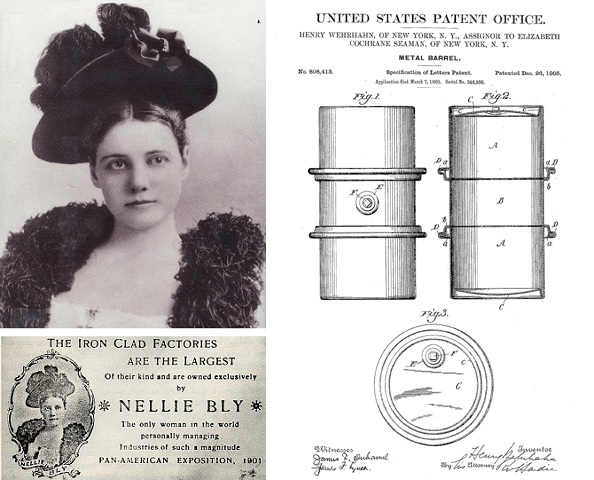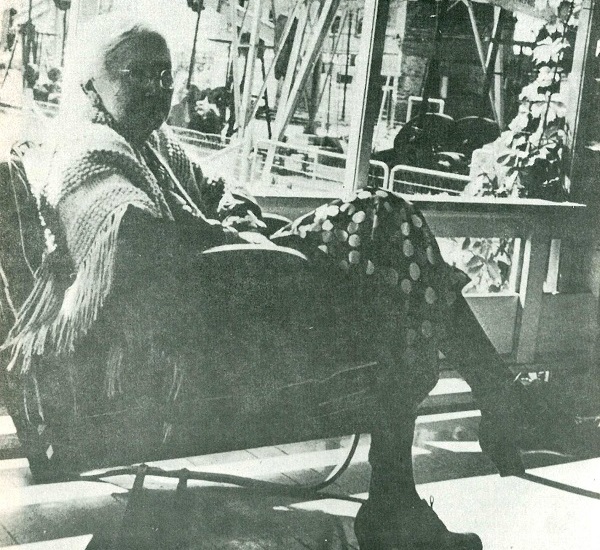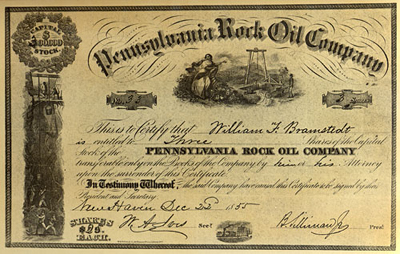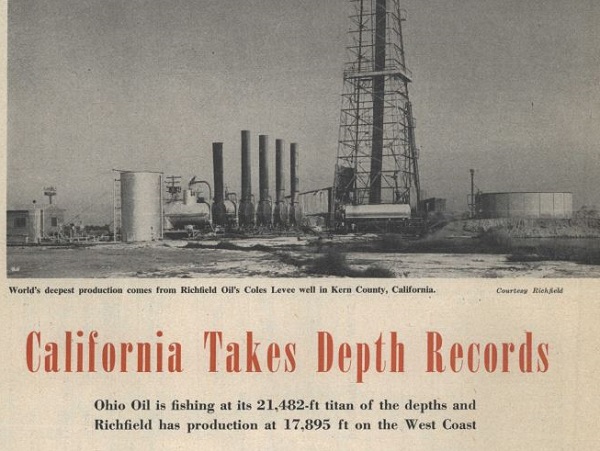December 26, 1905 – Nellie Bly’s Ironclad 55-Gallon Metal Barrel –
Inventor Henry Wehrhahn of Brooklyn, New York, received two patents that would lead to the modern 55-gallon steel drum. He assigned both to his employer, the famous journalist Nellie Bly, who was president of the Iron Clad Manufacturing Company.
“My invention has for its object to provide a metal barrel which shall be simple and strong in construction and effective and durable in operation,” Wehrhahn noted. After receiving a second patent for detaching and securing a lid, he assigned them to Elizabeth Cochrane Seaman (Nellie Bly), the recent widow of the company’s founder, Robert Seaman.

Nellie Bly was assigned a 1905 patent for the “Metal Barrel” by its inventor, Henry Wehrhahn, who worked at her Iron Clad Manufacturing Company.
Well known as a reporter for the New York World, Bly manufactured early versions of the “Metal Barrel” that would become today’s 55-gallon steel drum. Wehrhahn later became superintendent of a steel tank company in Milwaukee, Wisconsin.
Learn more in the Remarkable Nellie Bly’s Oil Drum.
December 28, 2017 – Smithsonian features Mrs. Alford’s Nitro Factory
“The True Story of Mrs. Alford’s Nitroglycerin Factory,” proclaimed an article in Smithsonian magazine about the early oil industry. “Mary Alford remains the only woman known to own a dynamite and nitroglycerin factory,” the magazine added, crediting research by the American Oil & Gas Historical Society about the late-19th century owner of a nitroglycerin factory in Bradford, Pennsylvania.
With the giant Bradford field accounting for 83 percent of all the oil produced in the United States, Mrs. Alford became known as “an astute businesswoman in the midst of America’s first billion-dollar oilfield.”
Learn more in Mrs. Alford’s Nitro Factory.
December 28, 1930 – Wildcat Well reveals More of East Texas Oilfield
Three days after Christmas, a major oil discovery on the farm of the widow Lou Della Crim of Kilgore revealed the extent of the giant East Texas oilfield. Her son, J. Malcolm Crim, had ignored advice from most geologists and explored about 10 miles north of the field’s discovery well, drilled in October by Columbus “Dad” Joiner on the farm of another widow, Daisy Bradford.

“Mrs. Lou Della Crim sits on the porch of her house and contemplates the three producing wells in her front yard,” notes the caption of this undated photo courtesy Neal Campbell, Words and Pictures.
The Lou Della Crim No. 1 well erupted oil on a Sunday morning while “Mamma” Crim was attending church. The well initially produced 20,000 barrels of oil a day.
One month later and 15 miles farther north, a third wildcat well drilled by Fort Worth wildcatter W.A. “Monty” Moncrief confirmed the true size of the largest oilfield in the continental United States. The East Texas field would encompass more than 480 square miles.
Learn more in Lou Della Crim Revealed.
December 30, 1854 – First American Oil Company incorporates
George Bissell and six other investors incorporated the Pennsylvania Rock Oil Company of New York. Convinced oil could be found in northwestern Pennsylvania, Bissell formed this first U.S. petroleum exploration company “to raise, manufacture, procure and sell Rock Oil” from Hibbard Farm in Venango County (see George Bissell’s Oil Seeps).

America’s first oil company incorporated on December 30, 1854, in Albany. George Bissell wanted oil for a new product: kerosene.
In 1855, after struggling to attract investors, the company reorganized under Connecticut corporate law, which protected shareholders from company debts. The Wall Street Panic of 1857 rendered control of the company to New Haven financier Robert Townsend, who re-incorporated it as the Seneca Oil Company of New Haven, Connecticut, in March 1858.
Townsend and Bissell hired former railroad conductor Edwin L. Drake to drill a well on the the 105-acre Hibbard Farm lease, which led to the first U.S. oil well in 1859.
December 31, 1954 – Ohio Oil Company sets Depth Record
As deep drilling technologies continued to advance in the 1950s, a record depth of 21,482 feet was reached by the Ohio Oil Company in California. The well was about 17 miles southwest of Bakersfield in prolific Kern County, in the San Joaquin Valley. At more than four miles deep, the well’s down-hole drilling technology was not up to the task and the bit got stuck.

A January 1954 trade magazine noted the record depth reached by the Ohio Oil Company’s deep well in Kern County — a dry hole.
Petroleum Engineer noted the well set a depth record, despite being “halted by a fishing job” and ending up as a dry hole. More than 630 exploratory wells were drilled in California during 1954.
Founded in 1887, the Ohio Oil Company discovered the Permian Basin’s giant Yates field in 1926 and later purchased Transcontinental Oil, acquiring the Marathon product name — and Greek runner trademark.
December 31, 1998 – Amoco merges with BP
Amoco completed its merger with British Petroleum in a stock swap valued at about $48 billion, at the time the world’s largest industrial merger and the largest foreign takeover of an American company. Amoco, founded in 1889 as John D. Rockefeller’s Standard Oil Company of Indiana, had changed its name to Amoco in 1985.

BP closed all Amoco stations in 2001, three years after acquiring the former Standard Oil Company of Indiana.
BP shareholders owned 60 percent of the newly combined companies, BP Amoco, PLC. The company in 2001 changed its brand to simply “BP,” and began closing or renaming Amoco service stations. In 2017, BP announced reintroduction of the Amoco brand to the United States, 105 years after the first Amoco service station opened in Minneapolis, Minnesota.
December 31, 1999 – Pegasus returns to Dallas Skyline
As millennium celebration fireworks began at midnight in Dallas, Texas, an oil company marketing icon soared again atop the 29-story Magnolia Building. The new version of Mobil Oil’s Pegasus replaced a badly deteriorated original, which had first rotated there in 1934. “You can’t tell the new one from the old one except for the fact that the faces are now red and not rusty,” noted one of the restorers.
The downtown building’s first 11-foot “Flying Red Horse” would be lost and almost forgotten until 2015, when it was discovered in a storage facility. After extensive renovation, the petroleum industry artifact landed in front of the Omni Dallas Hotel, where it can be seen today.
Learn more in Mobil’s High-Flying Trademark.
_______________________
Recommended Reading: Nellie Bly: Daredevil, Reporter, Feminist (1994); Images of America: Around Bradford
(1997); The Black Giant: A History of the East Texas Oil Field…
(2003); Myth, Legend, Reality: Edwin Laurentine Drake and the Early Oil Industry
(2009); Portrait in Oil: How Ohio Oil Company Grew to Become Marathon
(1962). Your Amazon purchase benefits the American Oil & Gas Historical Society. As an Amazon Associate, AOGHS earns a commission from qualifying purchases.
_______________________
The American Oil & Gas Historical Society (AOGHS) preserves U.S. petroleum history. Become an AOGHS annual supporting member and help maintain this energy education website and expand historical research. For more information, contact bawells@aoghs.org. Copyright © 2023 Bruce A. Wells. All rights reserved.


